BTW, I had a nice writeup of the pictures, taken from a flyer in the north transcept, but must have misfiled it somewhere on my system. For now, though, I'm just so excited about having pictures up at all that I'll post them without comment for the time being--after all, we want people to see the beauty of this little church before the Archbishop closes it down, don't we? And yes, I know the aspect ratio is screwed up on the new pictures. I'll fix that at some point as I get more comfortable with HTML and off-blogger photo hosting.
Original Post: March 25: Here are some pictures of St. John the Baptist, the Croatian
 church standing at the top of Strawberry Hill in Kansas City, Kansas. This is the church that you can't miss when you come west over the West Bottoms via the Lewis & Clark Viaduct (I-70). It's one of the few old ethnic churches that hasn't lost its ethnic flavor. A few years ago when I first peeked inside, I walked up the steps behind several old men speaking in what sounded like Croatian.
church standing at the top of Strawberry Hill in Kansas City, Kansas. This is the church that you can't miss when you come west over the West Bottoms via the Lewis & Clark Viaduct (I-70). It's one of the few old ethnic churches that hasn't lost its ethnic flavor. A few years ago when I first peeked inside, I walked up the steps behind several old men speaking in what sounded like Croatian.
For some time, I've postponed this post, primarily because I've wanted to include interior pictures. My friend, Orville Dishwater, took some photographs with his 35mm years ago on a tour. However (judging from the proof sheet in the package he gave me), he took some of the
 very best photographs out of the set, perhaps to share with someone else, and so the interior shots I have are (although good) incomplete in this case--they don't include a shot of the High Altar (which judging from the 1cm x 1.5cm image on the proof sheet, was a very nice picture). These interior pictures are just a tease.
very best photographs out of the set, perhaps to share with someone else, and so the interior shots I have are (although good) incomplete in this case--they don't include a shot of the High Altar (which judging from the 1cm x 1.5cm image on the proof sheet, was a very nice picture). These interior pictures are just a tease.So, anyways, it's been a few months since I resolved to get over there again and take interior pictures, and I've
 still failed to make it at a time when the church was open but Mass or other functions weren't happening. I'm going to try again, and when I finally succeed (if I succeed before the Archbishop closes the church and sells it off to someone to convert into lofts or a bed and breakfast or a heretical meeting house or a gay bar), I'll fill in this post with more interior pictures and some history (beyond the short blurb I've pasted in below).
still failed to make it at a time when the church was open but Mass or other functions weren't happening. I'm going to try again, and when I finally succeed (if I succeed before the Archbishop closes the church and sells it off to someone to convert into lofts or a bed and breakfast or a heretical meeting house or a gay bar), I'll fill in this post with more interior pictures and some history (beyond the short blurb I've pasted in below).The church grounds include a former orphanage and and school (not the
 Strawberry Hill Museum) which is connected to the church by a pedestrian drawbridge over an alley. I've been told that there is a bowling alley and a bar in the basement of this church; however, I have not confirmed this.
Strawberry Hill Museum) which is connected to the church by a pedestrian drawbridge over an alley. I've been told that there is a bowling alley and a bar in the basement of this church; however, I have not confirmed this.The interior is very pretty, as I recall, with a Central-European Roccoco thing going on (a pastel pallate, if I remember correctly, but not kitschy). I will get more pictures at some point, I promise.
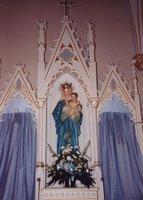 Transcribed from History of Wyandotte County Kansas and its people ed. and comp. by Perl W. Morgan. Chicago, The Lewis publishing company, 1911. 2 v. front., illus., plates, ports., fold. map. 28 cm. [Vol. 2 contains biographical data. Paged continuously.]
Transcribed from History of Wyandotte County Kansas and its people ed. and comp. by Perl W. Morgan. Chicago, The Lewis publishing company, 1911. 2 v. front., illus., plates, ports., fold. map. 28 cm. [Vol. 2 contains biographical data. Paged continuously.] ST. JOHN'S CROATIAN CHURCH.
A handsome church used by the Croatian nationality stands at Fourth street and Barnett avenue. It is called the church of St. John the Baptist and is presided over by Father M. D. Krmpotic. The church was built by this clergyman at a cost of $25,000. The architecture is of pure Gothic type, and its interior furnishings are of the finest material. The walls are decorated with paintings of Biblical scenes and characters by artists who came from Croatia for that purpose, The parish also has a $3,000 residence and maintains a school where more than one hundred Croatian children attend and receive instruction in the common branches and good citizenship. There are almost two hundred families in the parish besides about three hundred single men who are members of the congregation.
Updated with photos taken June 20, 2006
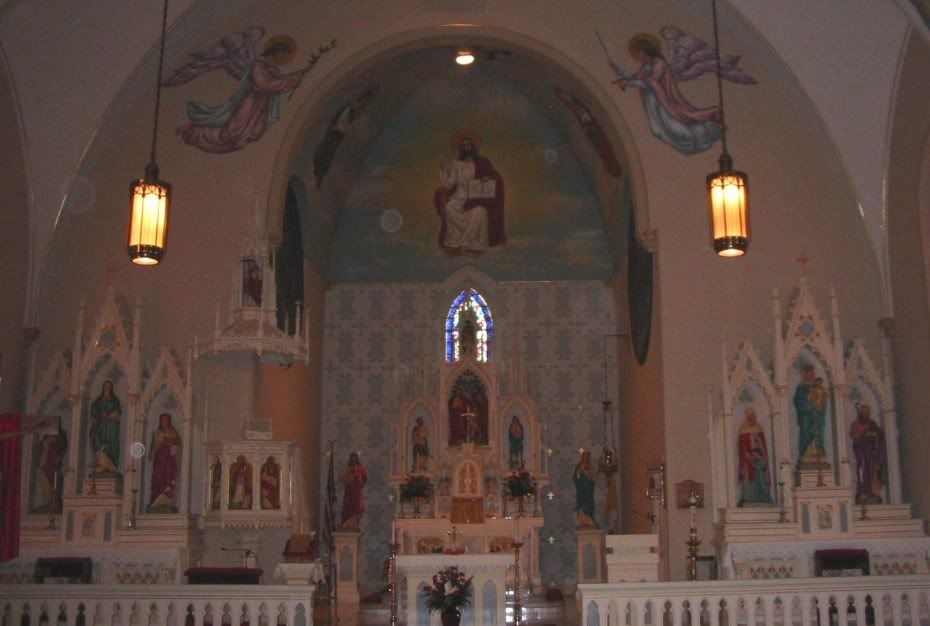
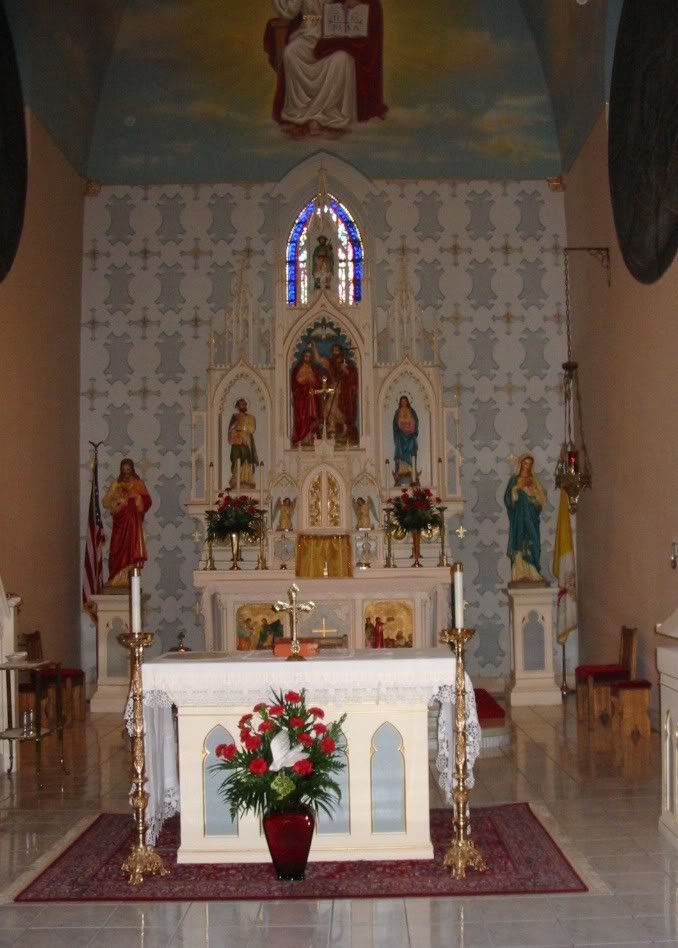
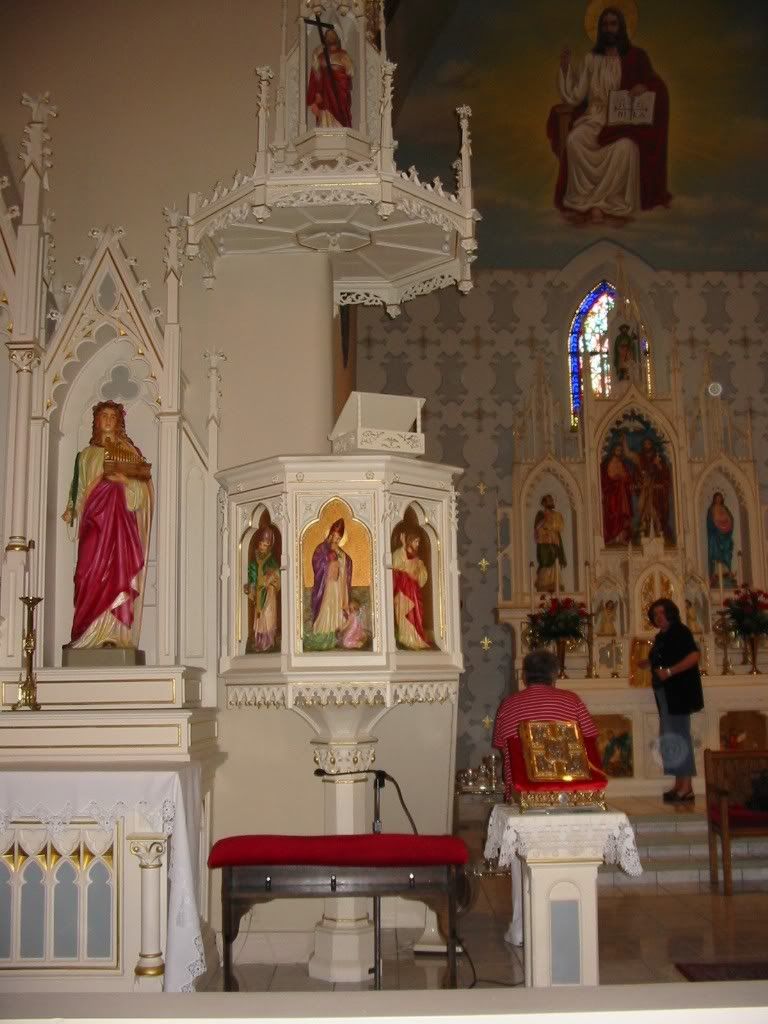
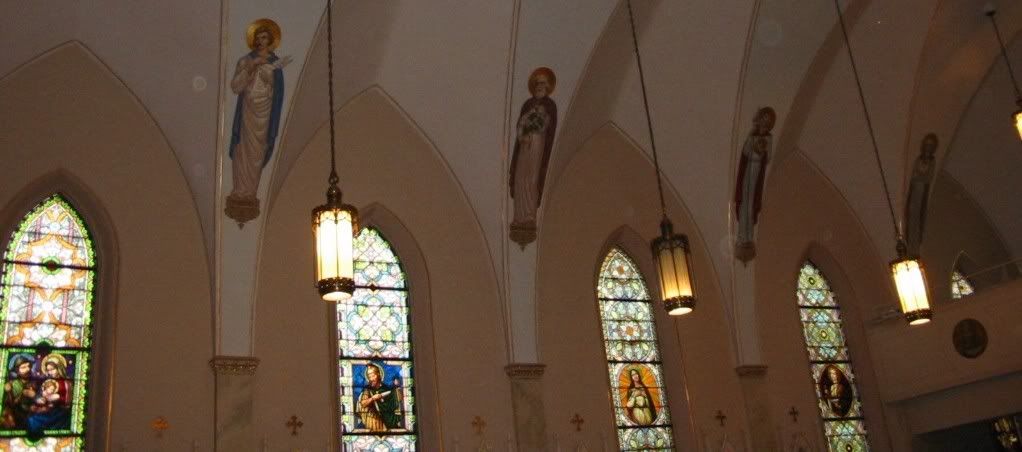
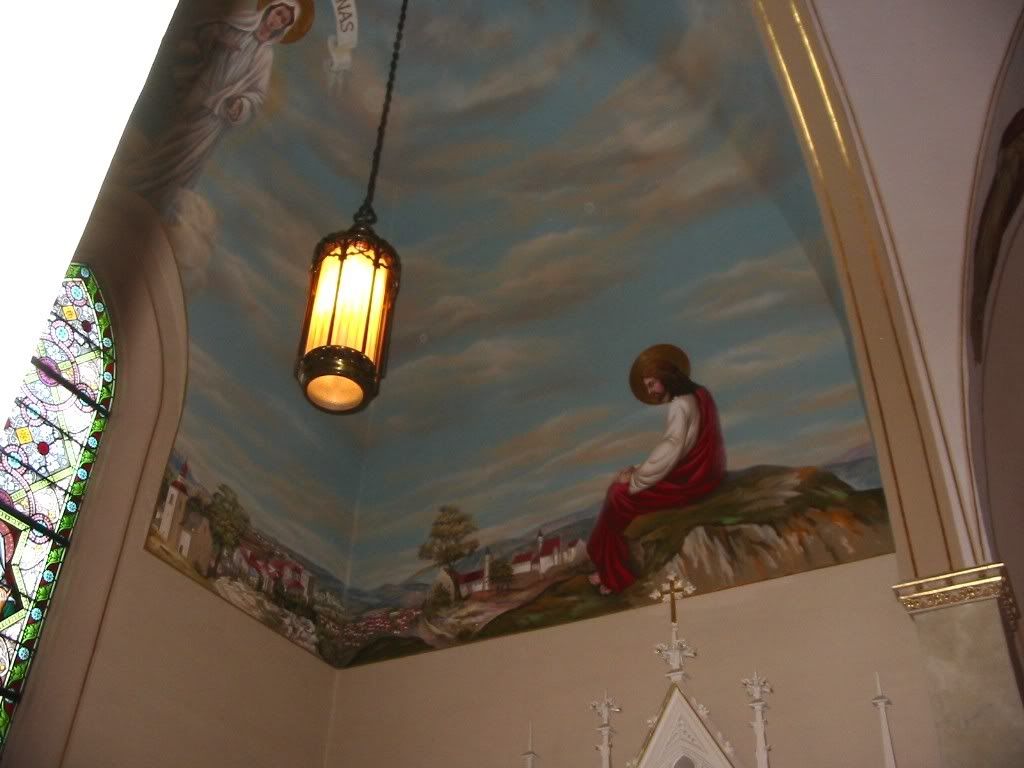
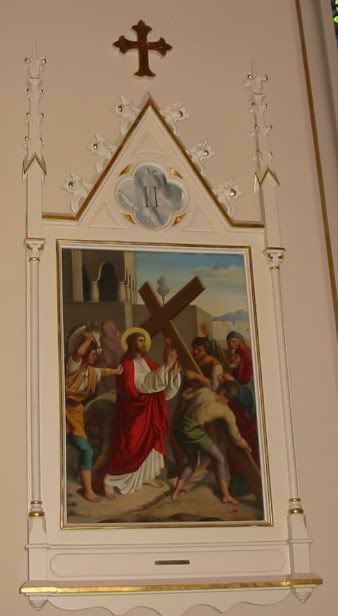




18 comments:
I don't think that they will close St. John the Baptist. I think the committee will decide to close St Cyril’s and Methodius—only a Saturday Mass now and no priest there. Holy Family will close when Monsignor dies or is unable to continue. St. Rose and Our Lady. Possible will merge with Blessed Sacrament. Sacred Heart –KC K_ will be merged into St. John Evangelist. There are now two churches, one priest and one school. Speaking of schools rumor hath it that Holy Family now merged with St. John Baptist school may wind up with St.Peter. St Joseph/ St Benedict All Saints School- is bursting with kids—a lot of Hispanic- but they have $$$$ problems as not everyone can afford or pays the tuition. They paying tuition problem as I understand it is a problem even in Johnson County.
Place your bets!
I think this church is one of the finest in Kansas City. I have been a member of this church my whole life and would hate to see it close. Many people still come to mass each weekend (some drive 20-30 miles to come to mass!) Also, the church does indeed have a bowling alley, however it is not in the church basement, but in the Croatian Catholic Club building right next to the church.
The Midwest Croatians website at: http://www.midwest-croatians.org/archives/stjohnkc.html has a nice writeup on the parish.
St. John the Baptist Croatian Catholic Church
The history of Saint John the Baptist Catholic Church is the history of the Croatian people, their religious faith, and the struggle to keep that faith alive while adapting to the culture and customs of their adopted country
The first of these settlers tasted the bitter experiences of strangers in a strange land. Unfamiliar with the language and the customs, they had no friends, no countrymen. These good people could not answer even the ordinary questions requiring simple yes or no answers. The thoughts of many in those early days turned to their far-away fatherland, and the recollection was often accompanied by deep sighs and tears. "Pogledaj na mene i smiluj mi se, Gospode, jer sam stranac i siromasan." (ps. 24)
As soon as the earliest immigrants, the pioneers, had settled and learned to speak and write English, other immigrants followed. Newcomers were always welcomed with a feast prepared by relatives, friends and neighbors. No sooner had a new arrival rested from his journey than the "old timers" would begin the task of finding him employment in a plant or a factory. He would be hired and begin saving his wages to send home to his parents or wife. His wages were earned by the sweat of his brow. Sweet were the crumbs acquired in this manner.
As early as 1888, a number of Croatians settled in this mid-central region of the United States, in the city of Kansas City, Kasnas, formerly called Wyandot, which was the name of a tribe of Indians who were moved by the Federal Government to this area from the East.
The earliest immigrants were Ivan Jarnevic, Josip Grisnik, Jure Novak, Janko Car, the brothers Imbro and Miho Skorija, Ivan Crnic, Marko Lorkovic, Ivan Goldasic, Ivan Maca, the brothers Jure and Franjo Ribic and the first female immigrant, Ann Sambol, later Kostelac. These and others who came to the New Wold were witnesses to the lives and experiences of the original Croatian immigrants to Kansas City, Kansas.
A house could be purchased for a very reasonable amout of about $500.00 The rent on the real estate was about $1.00 or more per month.In their own homes the new arrivals were their masters. The familiar frangrances blooming in the fields of their homeland were replaced by the stnch of the slaughterhouses and the stockyards, by the smoke emitted from the railroad locomotives and the fumes from the smokestacks of industry.
As the number of Croatian families increased, the people began to talk about building a parish church of their own. On May 26, 1900, the Croatians met in Union Hall on West 9th Street in Kansas City, Missouri. On June 26, 1900, it was announced that the property comprising 7 lots, each 25 x 150 feet in dimension, had been pruchased for $1,650.00.
The time between October 20, 1900 and February 28, 1901 was spent in collecting funds, selecting members for the building committee, securing a contractor for the church building, and corresponding with priests in Croatia in search for a pastor.
The cornerstone of the church was solemnly blessed by the Very Reverend Thomas Moore, V.G., on the 15th day of May, 1904. A magnificent parade accompanied this event.
On June 28, 1902, Father Martin Davorin Krmpotic arrived in Kansas City, Kansas from Croatia. He began to work in all earnestness to complete the building of the church. As he knew a great deal about stone masonry, he went out and worked with the rest of the workmen. On one occasion a union agent happened along and asked Father Krmpotic for his union card. The priest looked at the gentleman, smiled, and replied: "I do not need any union card; I am building my own church." He added: "I don't think that St. Paul had a union card while he carried on his trade of tentmaking."
The flood of 1903 dealt the "Patch" area a mortal blow. The Missouri and Kansas Rivers flooded the entire part of the city which lay along the Missouri near the mouth of the Kansas River. After the flood, a few of the people returned to the "Patch", but most relocated to the immediate vicinity of the new church building which was under construction, the better to rear and educate their children in the spirit and faith of their ancestors. The area became to be known as "Mala Hrvatska" (Little Croatia).
Through Father Krmpotic's influence, Oton Ivekovic, belonging to the school of painting at the University of Zagreb, Croatia, was called to fresco the church in 1908. He felt honored as this was the first time he was invited to exhibit his skill in America. With his brush and easel he set to work, being mindful of the words of the poet Keats, "A thing of beauty is a joy forever." His great genius was poured into his work of art.
In 1907, a new frame building housing the first Croatian Catholic School in the United States was blessed. The Sister of the Precious Blood were the first teachers but they were recalled. On October 11, 1909, four Sisters of St. Francis arrived from Maribor. Throughout the years sisters of this order have conducted the school with zeal and devotion.
In 1918, there was an influenza epidemic. It took a tremendous toll among the Croatian people. Many children lost their parents. In some cases many widowed mothers were forced to seek employment to gain a livelihood for their little ones. Father Krmpotic called a meeting of the parishioners, acquainted them with the dire conditions that existed, and proposed the building of an orphanage and day nursery. The orphanage would be for those children left without parents and the day nursery for the care of the children whose mothers had to work. Father Krmpotic sought and obtained the consent of the Franciscan Sister to supervise the orphanage. Today this building is the home of the Strawberry Hill Ethnic Museum.
In the 1950's, the Department of Transportation swept through this ethnic community and razed almost half the homes in the area. Despite this enormous setback, this parish still thrives. It has still maintained it's school and the parish community still thrives. Many old-time parishioners still drive twenty to thirty miles each Sunday to attend Mass. The Church's current parish priest, Father Frank Horvat, has tried to continue the traditions of the past for his parishoners while bringing up-to-date with the 21st Century. It is the hope of the parishioners that the Croatian tradition will still be kept alive as a reminder to those who helped begin this parish over 100 years ago.
This country has given haven to millions of immigrants from southern and eastern Europe during the past century. They came to the teeming cities and ethnic neighborhoods of every metropolitan area in the United States. Many were absorbed completely and lost their identity. Our pioneer fathers clung tenaciously to their Catholic and Croatian identity while absorbing the best of American Citizenship. They have given their children every advantage that this great country can provide, but they have not permitted their ethnic identity and the richness of their heritage to be forgotten.
Archbishop Jean Jadot, then Apostolic Delegate to the United States, stated: "There is a realization that there are important values in one's own ethnic and cultural traditions and in the tradition of others, which should not be submerged and snuffed out, but rather cherished and preserved."
As Saint John the Baptist Croatian Catholic Church celebrated its 100th anniversary, that dream of continuing the Croatian tradition of our ancestors burns so brightly. May the members of all the Croatian communities realize that their heritage is not a birthright, but a responsibility to continue what has been given to them.
Source: Text taken from the Diamond Jubilee 75th Anniversary Book of Saint John the Baptist Church.
Instead of closing St John the Baptist church, maybe Bishop Naumann could give it the the St Phillipine Duchesne Community.
Seriously, it's unlikely that this one will get closed. This in one that seems to be pretty full, but it's certainly possible that it will be closed. If it were, the Archbishop cold make more money by selling it to someone who wanted to open a bed and breakfast or something. The view is pretty good.
I don't think that anyone (or at least any responsible person) at the SRPD community is floating around in the sky like a carrion bird, waiting a road kill in order to score a home. My SRDP rant is more about our standing with the diocese than it is about any physical location.
At any rate, let's just take a look at this church and the others I hope to update on their own merits, separate and apart from any of the SRPD issues.
More information about St. John's Croatian Church and the Croatian community in Kansas City can be found at this website: http://strawberryhillkc.org/
Does anyone out there have any info on Monsignor Karlo Stimac?
He was my wife's great-grand uncle.
My wife, and her family is from Croatia. Her mother's mother (stimac) family was from Slovenia. Karlo/charles probably left in the early 1920-30s. We know that he was a monsignor at St. John the Baptist Parish in KS. Please, if anyone knows of him or has pictures, our email is mirtakatnich@hotmail.com
Very nice Catholic Church. I will love to get there and learn about it. It's one of the few old ethnic churches that hasn't lost its ethnic flavor. Viagra Online
wow... wonderful pics. I got good information with the help of your article. I read the comments also.. they have mentioned the good history of St. John the Baptist Croatian Catholic Church. Good job! Keep posting.
I liked this blog, i think is very interesting, most of all for the new ideas that this blog talk.
My name is Victor Love, I was a "student" living in the Orphanage from 1954 to 1963.
Curmudgeon
There was a bowling alley, but it was in the basement of the school, not the church. There was a fountain counter with snacks but no bar. The Church basement was used for football/baseball dressing room and on fridays we had Cub and Boyscout meetings.
We practiced and played in "bums field" Directly across from the orphanage and under the Kaw River bridge.
The alley between the Church and the Orphanage was a great place to sled in the winter if the Nuns didn't catch me.
I was the first boy to be allowed by the nuns to participate in sports and Scouting.
Sister Superior
Sister Mary Daniel
Sister Mary Tereasa
Sister Mary Collette
Sister Mary Petronella
Sister Mary David
Sister Mary Joseph
And the Rest whose name time has erroded.
Thank you for the unconditional love and discipline needed to keep this Montana boy in check.
After Katrina hit N.O. La. I volunteered with Habitat to repair roofs, 18 months later I am on the Train back home with my new guitar and another fella came on with his guitar, turns out he was a former St.Johns boy.
Seems the Nuns had taken to describing things as "that's something Victor would do" when another student did something dangerous or stupid.
I also want to thank the Croatian community for 'adopting me" when I received my first sacraments, hiring me to set pins on Saturday nights, inviting me on sleep overs and for the numerous unearned birthday and Christmas gifts, for paying my Scouting dues and Camp Kickapoo and Jamborees THANK YOU!!!
I may not be Croatian, but I know a little what it means to be Croatian.
good topic and well written This blog is really great. I really appreciate how ways were laid. Very interesting. Thank you for the great tutorial and the wonderful inspiration.
dear Victor, I'm Helen Cowan. I was also a student at the Orphanage during 1956-19957. my favorite nun was Sister Collette. very glad to hear about someone who was there also, just recently visited the Strawberry Hill Museum there for the Christmas tour. would like to share some thoughts and talk if you'd like. Yadoninsurance@yahoo.com
Helen this is Carter Baxter I was in the orphanage from 1950 to 1960 when I graduated and sent to father Flanagan's boys town .sister Collette left the order and got married she lived in Independence MO. She died and is barried somewhere there.
I was also at the orphanage. There were 5 of us in there for 4 years. 1954 - 1958. 3 brothers, my sister and I. I am still very disciplined in everything I do. I made my first communion there. I remember the tap dance lessons. Sister Mary Collette was our favorite too. In kindergarten I had sister Mary Prokseta (sp). That little house in her classroom for those who had a birthday. I had twins in my class Mary and Agnes. I went home with them one day after school. The nuns looked for me, I was 5 and didn’t know I couldn’t go play at someone’s house. I’ve been back a couple of times for a tour. It was difficult for a couple of us. There’s a lot of history there,
There was 5 of us siblings there from 1954 - 1958.
Post a Comment